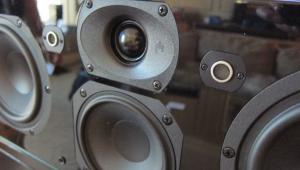CES 2012: The Golden Age of Wireless? Page 2
WiSA in Action
The system Summit Semiconductor showed off (Aperion Audio's Intimus 4T, though demonstrated with a Summit-branded master unit) was a fully wireless 5.1 setup using what's currently the most complete implementation of the WiSA spec - a system that uses ultrasonic transducers mounted on the front panel of each speaker to automatically locate themselves and the listener in the surround field.
A fundamental problem with many current wireless systems is that they're operating over Wi-Fi in the crowded 2.4 GHz band. WiSA instead uses the far less congested U-NII (for "Unlicensed National Information Infrastructure") band, the area of the radio spectrum between 5.2 and 5.8 Ghz, used previously by military radar systems and thinly populated with commercial signals. The Summit guys were running a wireless sniffer, and the difference is, well, obvious, as you can see in the images to your right.
Functionality is impressively smooth. The remote control also includes a transceiver. Sit where you like, hit the "my zone" key, and the system automatically calibrates itself to position the sweet spot at your location. The transition is very fast (the curve of the amplitude changes is part of the WiSA spec), glitch free, and hardly noticeable.
Also demonstrated were two prototype systems that represent what might be implemented by manufactures looking to hit even lower price points - including a couple of prototypes (built by Summit's Lincoln Wilde) of wireless soundbar-and-subwoofer combos that a speaker manufacturer-who-could-not-be-named may be bringing to market as early as sometime in the first quarter of this year at around $500 and $750, as well as a 5.1. configuration meant to sell for around $1,000.
While Summit obviously knew more than they were letting on, those prices and delivery schedules are all speculative, obviously, so don't go placing any orders just yet. But a fully wireless surround speaker system delivering lossless audio for around the price of a quality soundbar would be an impressive achievement, especially if it sounds as good as what I heard in the demo.
At the lower price points, some WiSA-defined functionality is abandoned - the front speakers don't include the ultrasonic transducers, so they can't automatically locate themselves (but that also opens up the possibility of using wired L, R, and center channels and wireless for the more-difficult-to-place surround channels and sub). Rather, an iPad remote control app lets the viewer/listener enter room size dimensions and indicate the position of the speakers via a GUI; the system corrections are then made accordingly. Seems like a letdown, but then again, the resolution of the human eye is a whole lot better than the resolution of the human ear, which is what you've probably been using to place your speakers so far. And it's very simple to set up.
Based on Summit's pint-sized 15-watt digital amplifiers (the entire module, including transceivers, DSP, and amplification is slimmed down considerably by comparison with what the company was showing two years ago in prototype, and should be easy to incorporate into even small speaker cabinet designs), the system delivered impressive levels - and, more importantly, quite good sound quality. If there's any way to sell consumers on HTiBs these days, this may be it.














































